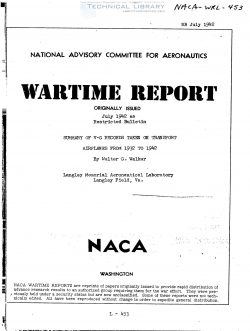naca-wr-l-453
- Version
- 76 Downloads
- 567.60 KB File Size
- 1 File Count
- April 3, 2017 Create Date
- April 3, 2017 Last Updated
Summary of V-G Records Taken on Transport Airplanes from 1932 to 1942

L-453
since the preparation of the last report on gust
loads a large number of records hayereen obtained from
V-G recorders installed in airplanes'flying on the do-
mestic and transoceanic transport air lines of the United
States. Records totaling-more than 134.000 flying hours
have been received and evaluated in order to bring up
to date the 7-0 reoorder_data. The analysis of these
records is contained in this report.
The results indicate that the maximum effective
gust velocities for both the land transport airplanes
and the flying boats have approached values of :40
feet per second. This value is discussed with refer-
ence to the present design gust load factor and it is
concluded that the present design factor is adequate
when all the factors affecting the maximum effective
gust velOcities are considered.
INTRODUCTION
Since the preparation in 1937 of reference 1. the
number of V-G recorder flight hours has been increased
from about 20,000 hours to more than 134,000 hours. At
the same time several new types of airplane have been
placed in regular service on the air lines. These air-
planes are much larger and. in some cases. have higher
wing loading values than the old types they have re-
placed. In 1937 the ratio of flight time accumulated
on land transports-to that of flying boats was about
6 to 1, whereas at the present time the ratio is very
near unity. Likewise the wing loadings of the land-
planee and the flying boats are more nearly equal at
the present time than in 1937. The approach toward
parity of these quantities permits at the present time
—
a more reasonable compariucn between the records taken
on the landplanes and on the flying boats than was pos-
sible in 1937. '
The transport air lines of the United states have
been very cooperative with the race by installing Y-G
recorders in transport airplanes_and periodically re-
turning the records obtained on these airplanes with
the pertinent data required to evaluate the records;
This procedure has made it possible to obtain a large
amount of V—G recorder data from transport airplanes.
METHOD AND RESULTS
Scope of mg;surements.- The scope of the 7-6 data
obtained to date is presented in table I'in terms of the
type of airplane in which the 7-0 recorders have been
installed and the tdtal number of flying hours for each
type of airplane.
Figure 1 shows the monthly distribution of flying
time from October 1932 to April 1942. The chart shows
a total of over 134.000 flying hours for this period of
time.
Composite V—G diagrams.- The results of the eval-
uated V—G records are given as composite plots for the
different types of landplane in figure 2 and for the
different flying boats in figure 3. Formal acceleration
values in terms of g are plotted against.indicated air-
speed: envelopes of the maximum g values are shown for
all the v-s records taken on each type of airplane.
| File | Action |
|---|---|
| naca-wr-l-453 Summary of V-G Records Taken on Transport Airplanes from 1932 to 1942.pdf | Download |

Comment On This Post